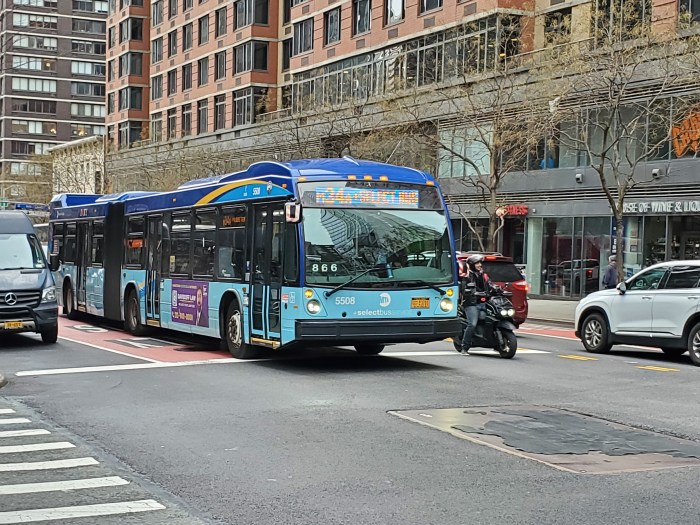
When Jimmy Colter, a Williamsburg-based dancer, looks to lock up his bicycle around the city, he inevitably notices a seemingly abandoned bike, completely stripped of its parts, taking up valuable space. He curses under his breath and moves on.
“It’s part of biking in the city,” Colter shrugged, as he parked his bike on Bedford Avenue on a recent Sunday. “You see bikes everywhere with wheels stolen, seats stolen, or the lock is rusted out.”
Cycling has surged in New York City in recent years. There was a 320% increase in daily cycling between 1990 and 2014, from 100,000 trips to 420,000, according to a recent city report. With that has come an influx in abandoned or derelict bicycles that are left to rust in their u-locks — occupying much-needed parking spots and creating trip hazards on sidewalks.
Determining when a bike is actually derelict can be tricky and the Sanitation Department has followed strict guidelines in order to keep from taking personal property.
If a bike is identified as derelict, it will be tagged with a Sanitation sticker and the owner will have seven days to remove it. Current rules dictate that for a bike to be considered derelict, it must meet three of the following criteria.
— The bike is crushed or not usable.
— The bike is missing parts, other than the seat and front wheel.
— The bike has flat. or missing tires.
— This bike has damaged handlebars or pedals, or bent forks, frame or rims.
— The bike is at least 75% rusted.
Still, many clearly derelict bikes manage to slip through the cracks, according to advocates. Sanitation addresses potentially abandoned bikes through 311 complaints. Between 2010 and Aug. 13, 2016, there were about 5,874 complaints relating to derelict bicycles. A total of about 1,308, or about 21%, led to the removal of the bikes, according to Sanitation.
The department said the low removal rate is due to a variety of factors: The bike in question was not found at the location; the bike was tagged, but moved by the owner; or the bike failed to meet guidelines for removal.
“If people watch that a bike missing a seat post sits around for a week or two, then the wheel is gone; the fork is gone,” said Karen Overton, executive director at Recycle-A-Bicycle. “There’s this process of deterioration because the city is not collecting the bikes quickly enough and it’s actually encouraging theft.”
To address what the agency considers a growing trend, Sanitation has proposed loosening three elements of its guidelines to remove bikes more easily. Under the proposal, Sanitation would drop the number of required criteria from three to two; remove flat or missing tires from the list, and lower the rust requirement to 50%.
Councilman Antonio Reynoso, chair of the Committee on Sanitation, supports the rule changes as a more sensible approach to the issue.
“As cycling continues to grow in popularity, we need to grow with the times,” Reynoso said. “Sanitation has very stringent laws as to what they can and cannot take. So we need to modify those laws to speak to today’s time.”
But Overton, who spoke at a public hearing relating to the rule changes on Aug. 9, said the proposed rule revisions don’t go far enough to allow for Sanitation to more aggressively take bikes. Overton believes a single removal criteria should be established for five specific characteristics, like bikes with crushed frames, those that are missing both wheels, or those missing a front fork.
“All of these are serious and expensive missing parts,” Overton said. “Often, people will assess the cost of the parts and just abandon the bike.”
Sanitation currently scraps its derelict bicycles. But if the city could more aggressively remove bikes, Overton believes there would be more opportunity for New York to follow the lead of cities like San Francisco, Boston and Chicago, which donate bikes in partnership with community organizations for bike repair and reuse programs.
“As it is now, the city is only dealing with derelict bikes that are ready for the trash,” Overton said.
Reynoso said that he’s confident that Sanitation would remain flexible, should it need to further adjust its policy. Sanitation has not yet announced if or when the proposed changes would take effect.
“The Department of Sanitation will carefully consider all comments made at the public hearing held on Aug. 9th and all written comments received before publishing its final rule,” said Sanitation spokeswoman Kathy Dawkins in an email.
Abandoned bike complaints to 311
2016: 1,303 reported through 8/13/16
2015: 1,281 reported
2014: 1,212 reported
2013: 766 reported
2012: 815 reported
2011: 409 reported
2010: 88 reported
Total reported 4,574
Total removed: 1,308, or 28.5%











